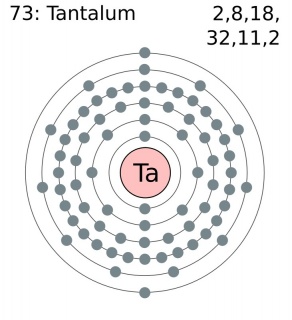The Discovery of Tantalum Metal
11.07.2019.In the mid-17th century, a heavy black mineral (the density of tantalum was 16.68g/cm cubed) found in North America was sent to the British Museum for storage. About 150 years later, in 1801, the British chemist, Charles hatchet accepted the task of analyzing this mineral from the British Museum. Then a new element was discovered and called Columbium, which was to commemorate the first place where the mineral was discovered -- Colombia.
Tantalum is named for Tantalus. In 1802, Swedish chemist A.G.Ekaberg analyzed a mineral (niobium-tantalum) in Scandinavia, and he made its acid produce fluorinated salts, then recrystallized, and discovered new elements. He named the element Tantalum (Tantalum), referring to the name of Tantalus, the son of Zeus god in Greek mythology.
Because colum and tantalum are very similar, they were once thought to be the same element. In 1809, the British chemist William Hyde Wollaston compared the oxide of tantalum and colum, although different densities were obtained, he thought they were the same substance.
By 1844, the German chemist, Heinrich Rose, rejected the conclusion that tantalum and columbium were the same elements, and they were identified by chemical methods as two distinct elements. He named the two elements "Niobium" and " Pelopium ", the daughter Niobe of Tantalus and his son Pelopium in Greek mythology.
In 1864, Christian Wilhelm Blomstrand and Louis Joseph Troost made it clear that tantalum and niobium were two different chemical elements and determined the chemical formulas of some related compounds.
In the same year, DE Mariia heated the tantalum chloride in the hydrogen environment to make the tantalum metal for the first time. In the early stage, the tantalum metal contains more impurities. Werner von Bolton first made pure tantalum metal in 1903.
It was first used by scientists to extract tantalum from niobium. This method was discovered in 1866 by DE Mariya. Today, the scientists used a solvent extraction method for tantalum containing fluoride.
Advanced Refractory Metals (ARM) is a leading supplier of tantalum products such as tantalum crucible, tantalum plate, tantalum ribbon, etc. with competitive price and great delivery time. Please visit https://www.refractorymetal.org for more information.
Oznake: tantalum ribbon, tantalum crucible, tantalum plate
komentiraj (0) * ispiši * #
How to Use Tantalum and Its Products Safely?
Tantalum (Ta) is obtained from tantalum ore and niobite which are mixed oxides of iron, manganese, niobium, and tantalum. Although they are considered rare elements, the earth's crust contains about 0.003% niobium and tantalum, which are chemically similar and often bound together.
Tantalum is mainly used in the production of capacitors, and tantalum powder is produced during pressing, sintering and anodizing. The oxide film on the surface acts as an insulator, and the high-performance capacitance is obtained when the electrolyte solution is introduced. Structurally, tantalum is used in a harsh environment with a high melting point, high density, and acid resistance. Tantalum is also used in railway signal rectifiers, suture surgery, bone repair, vacuum tubes, furnaces, knives, prosthetics, fiber spinneret, and laboratory equipment. Besides, tantalum carbide is used as an abrasive, while tantalum oxide is used to make special glass for high refractive index camera lenses.
The harm of tantalum
Tantalum powder is not as serious as other metals (zirconium, titanium, etc.), but there is a risk of fire and explosion. Tantalum's work carries the risk of burns, electric shocks, eyes, and trauma, while refining involves toxic and dangerous chemicals such as hydrogen fluoride, sodium, and organic solvents.
Both tantalum oxide and tantalum metal have low systemic toxicity, possibly due to their poor solubility, but they do cause damage to skin, eyes, and breathing. Among alloys of other metals such as cobalt, tungsten, and niobium, tantalum is believed to be the cause of skin damage caused by hard metal pneumoconiosis and hard metal dust.
Tantalum hydroxide has no toxic effect on chicken embryos, and intraperitoneal injection of tantalum hydroxide has no toxic effect on rats. However, tantalum chloride has an LD50 of 38mg/kg(Ta) when the compound salt K2TaF7 is about a quarter toxic.
Safety and health measures
In most operations, ventilation is used to maintain the dust concentration of tantalum and its compounds below the contact limit. Open fire, arc and spark should be avoided in areas where tantalum powder is treated. If workers are exposed to dust concentrations close to a critical level on a regular basis, they should have regular physical examinations, focusing on lung function. Precautions applicable to these compounds should be observed for tantalum fluoride and hydrogen fluoride containing operations.
Tantalum bromide (TaBr5), tantalum chloride (TaCl5) and tantalum fluoride (TaF5) should be stored in a cool and ventilated place with clear labels and away from compounds affected by acid or acidic smoke. Personnel concerned should be reminded of the danger.
Advanced Refractory Metals (ARM) is a leading supplier of tantalum products such as tantalum crucible, tantalum disc, tantalum ribbon, etc. with competitive price and great delivery time. Please visit https://www.refractorymetal.org for more information.
Oznake: tantalum ribbon, tantalum disc, tantalum crucible
komentiraj (0) * ispiši * #


